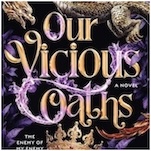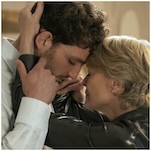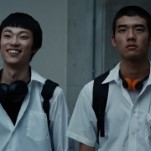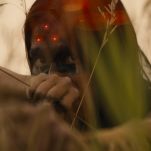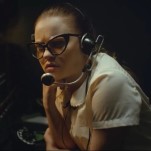The 35 Best Horror Movies on HBO Max Right Now (September 2025)

The first thing one notices, looking at the horror genre as it exists on HBO Max (formerly Max), is that there’s an unusual level of genuine curation involved here. The overall scope of the service might not be quite as broad as something like Netflix, but you’re likely to have heard of far more of these films. That’s because unlike the horror selections of Netflix, Hulu or (especially) Amazon Prime, the bulk of the selections here aren’t made up of modern, straight-to-VOD, zero-budget productions with vague, one-word titles like Desolation or Satanic. Rather, almost everything here received a wide release at some point.
That makes for an interesting horror library indeed, one that balances total schlock from Roger Corman with acclaimed works by the likes of Guillermo Del Toro and Stanley Kubrick. There are strange, foundational early horror films, such as Haxan or Vampyr, along with classics of world cinema like Japan’s Kwaidan, Onibaba and House. There are also indie gems like We’re All Going to the World’s Fair, or The Witch.
Regardless, of all the major streamers, HBO Max likely has the horror library most focused on what you’d call older “classics,” rather than newer releases—fine with us, considering that segment tends to be less well represented.
Here, then, are 35 best horror movies streaming on HBO Max Now.
You may also want to consult the following horror-centric lists:
The 100 best horror films of all time.
The 100 best vampire movies of all time.
The 50 best zombie movies of all time.
The 50 best movies about serial killers.
The 50 best slasher movies of all time
The 50 best ghost movies of all time.
The best horror movies streaming on Netflix.
The best horror movies streaming on Amazon Prime.
The best horror movies streaming on Hulu.
The best horror movies streaming on Shudder.
1. Se7en
Year: 1995
Director: David Fincher
Stars: Brad Pitt, Morgan Freeman, Gwyneth Paltrow, John C. McGinley
Rating: R
It’s hard to think of a movie that did more short-term damage to the length of your fingernails in the ’90s than David Fincher’s Se7en. Sticking close to detectives David Mills (Brad Pitt) and almost-retired William Somerset (Morgan Freeman) on the trail of John Doe, a murderer who plans his kills around the seven deadly sins, the film allows us to watch Somerset teach a still-naïve Mills valuable life lessons around the case, which has morally charged outcomes aimed at victims that include a gluttonous man and a greedy attorney. For all the disturbing crime scenes considered, Se7en’s never as unpredictable or emotionally draining as in its infamous finale, in which Mills and Somerset discover “what’s in the box” after capturing their man. —Tyler Kane
2. Kwaidan
Year: 1964
Director: Masaki Kobayashi
Stars: Rentaro Mikuni, Tatsuya Nakadai, Katsua Nakamura, Osamu Takizawa, Noboru Nakaya
Rating: NR
Ghost stories don’t get much more gorgeous than the four in Masaki Kobayashi’s sprawling Kwaidan. Between two acerbically political and widely lauded samurai epics, Hara-kiri (1962) and Samurai Rebellion (1967), Kobayashi led what was then Japan’s most expensive cinematic production ever, an anthology film with its parts loosely connected by Lafcadio Hearn’s collection of Japanese folk tales and Kobayashi’s intuitive penchant for surreal, sweepingly lush sets. In “The Black Hair,” a selfish, impoverished ronin (Rentaro Mikuni) abandons his wife to marry into wealth, only to realize he made a dire mistake, plunging him into a gothic nightmare of decay and regret. “The Woman of the Snow” follows a craftsman (the always welcome Tatsuya Nakadai) doomed to have everything he loves stolen from him by a patient bureaucratic specter. The movie-unto-itself, “Hoichi the Earless,” pits the titular blind monk musician (Katsua Nakamura) against a family of ghosts, forcing the bard to recite—in hushed, heartbreaking passages on the biwa—the story of their wartime demise. Rapt with indelible images (most well known, perhaps, is Hoichi’s skin completely covered in the script of The Heart Sutra to ward off the ghosts’ influence), “Hoichi the Earless” is both deeply unnerving and quietly tragic, wrung with the sadness of Kobayashi’s admission that only forces beyond our control hold the keys to our fates. The fourth, and by far the weirdest, entry, “In a Cup of Tea,” is a tale within a tale, purposely unfinished because the writer (Osamu Takizawa) who’s writing about a samurai (Noboru Nakaya) who keeps seeing an unfamiliar man (Kei Sato) in his cup of tea is in turn attacked by the malicious spirits he’s conjuring. From these disparate fairy tales, plenty of fodder for campfires, Kobayashi creates a mythos for his country’s haunted past: We are nothing if not the pawns of all those to come before. —Dom Sinacola
3. The Silence of the Lambs
Year: 1991
Director: Jonathan Demme
Stars: Jodie Foster, Anthony Hopkins, Scott Glenn, Ted Levine
Rating: R
The camera hugs her face, maybe trying to protect her though she needs no protection, and maybe just trying to see into her, to see what she sees, to understand why seeing what she sees is so important. Not even 30, Jodie Foster looks so much younger, surrounded in The Silence of the Lambs by men who tower over her, staring at her, flummoxed by her, perhaps wanting to protect her too, but more likely, more ironically, intimidated by a world that would allow such a fragile creature to wander the domain of monsters. As Clarice Starling, FBI agent-in-training, Foster is an innocent who’s seen more than any of us could ever imagine, a warrior who seems unsure of her prowess. That Jonathan Demme—a director who came up under the tutelage of Roger Corman, able to adopt then immediately shed genres at whim—corners Starling within the confines of a “Woman in Peril,” only to watch her shrug off every label thrown at her, is a testament to The Silence of the Lambs as feminist, not because it so thoroughly inhabits a female point of view, but because its violence and fear is the stuff of masculine toxicity. Demme’s film is only the second to adapt Thomas Harris’s Hannibal Lector novels to the screen, but it’s the first to draw undeniable lines between the way men see Clarice Starling and the way that serial killer Buffalo Bill (Ted Levine) projects his neuroses onto his victims. Demme (and Harris) links seeing to transformation to one’s need to consume, all pursued through a gendered lens, represented by the seemingly omniscient perspective of Hannibal Lector (Anthony Hopkins), a borderline asexual cannibal who literally eats those over whom he holds court. Buffalo Bill is a monster, and so is Lector, but the difference is that Lector does not attempt to possess Clarice Starling, though he sees her, because he is in control of that which he consumes. Buffalo Bill isn’t; as a man he believes that by consuming femininity he can become it, too stupid and too self-absorbed to realize that consumption is deletion, that wanting to protect a woman is only a matter of admitting that the World of Men is a weak and evil failure of the very ideals it strives to preserve. —Dom Sinacola
4. It Follows
Year: 2015
Director: David Robert Mitchell
Stars: Maika Monroe, Keir Gilchrist, Olivia Luccardi, Lili Sepe, Daniel Zovatto, Jake Weary
Rating: R
The specter of Old Detroit haunts It Follows. In a dilapidating ice cream stand on 12 Mile, in the ’60s-style ranch homes of Ferndale or Berkley, in a game of Parcheesi played by pale teenagers with nasally, nothing accents—if you’ve never been, you’d never recognize the stale, gray nostalgia creeping into every corner of David Robert Mitchell’s terrifying film, but it’s there, and it feels like Metro Detroit. It Follows is a film that thrives in the borders, not so much about the horror that leaps out in front of you, but the deeper anxiety that waits at the verge of consciousness—until, one day soon, it’s there, reminding you that your time is limited, and that you will never be safe. Forget the risks of teenage sex, It Follows is a penetrating metaphor for growing up. —Dom Sinacola
5. Get Out
Year: 2017
Director: Jordan Peele
Stars: Daniel Kaluuya, Allison Williams, Bradley Whitford
Rating: R
Jordan Peele’s a natural behind the camera, but Get Out benefits most from its deceptively trim premise, a simplicity which belies rich thematic depth. Chris (Daniel Kaluuya) and Rose (Allison Williams) go to spend a weekend with her folks in their lavish upstate New York mansion, where they’re throwing the annual Armitage bash with all their friends in attendance. Chris immediately feels out of place; events escalate from there, taking the narrative in a ghastly direction that ultimately ties back to the unsettling sensation of being the “other” in a room full of people who aren’t like you—and never let you forget it. Put indelicately, Get Out is about being black and surrounded by whites who squeeze your biceps without asking, who fetishize you to your face, who analyze your blackness as if it’s a fashion trend. At best Chris’s ordeal is bizarre and dizzying, the kind of thing he might bitterly chuckle about in retrospect. At worst it’s a setup for such macabre developments as are found in the domain of horror. That’s the finest of lines Peele and Get Out walk without stumbling. The film doles out scariness in intervals, treating fright as a supplement to the inexplicable or the downright creepy. It’s an exercise in tension, where we can presume what’s happening in the Armitage household without necessarily being on the money, and that’s the fun of the film: It spaces its revelations carefully, building on each to undercut any hint of a twist, while still catching us off our guard. When we’re exposed to the whole truth of Get Out’s race dynamic, it feels like a gut punch instead of a bombshell. —Andy Crump
6. Godzilla
Year: 1954
Director: Ishiro Honda
Stars: Sachio Sakai, Takashi Shimura, Momoko Kochi, Akira Takarada
Rating: NR
Early in Godzilla, before the monster is even glimpsed off the shore of the island of Odo, a local fisherman tells visiting reporter Hagiwara (Sachio Sakai) about the play they’re watching, describing it as the last remaining vestige of the ancient “exorcism” his people once practiced. Hagiwara watches the actors “sacrifice” a young girl to the calamitous sea creature to satiate its hunger and cajole it into leaving some fish for the people to enjoy—at least until the next sacrifice. Ishiro Hondo’s smash hit monster movie—the first of its kind in Japan, the most expensive movie ever made in the country at the time, not even a decade after the atomic bombing of Hiroshima and Nagasaki—is, after 20-something sequels over three times as many years, a surprisingly elegiac exorcism of its own, a reminder of one nation’s continuing trauma during a time when the rest of the world jonesed to forget.
As J Hoberman describes in his essay for the film’s Criterion release, much of Honda’s disaster imagery is “coded in naturalism,” a verite-like glimpse of the harrowing destruction wrought by the beast but indistinguishable from the aftermath of the Americans’ attacks in 1945, especially when the U.S. and Russia, among other powers, were testing H-bombs in the Pacific in the early 1950s, bathing the Japanese in even more radiation than that in which they’d already been saturated. And yet, Godzilla is a sci-fi flick, replete with a “mad” scientist in an eye patch and a human in a rubber dinosaur suit flipping over model bridges. That Honda handles such goofiness with an unrelentingly poetic hand, purging his nation’s psychological grief in broadly intimate volleys, is nothing short of astounding. Shots of Godzilla trudging through thick smoke, spotlights highlighting his gaping maw as the Japanese military’s weapons do nothing but shock the dark with beautiful chiaroscuro, have been rarely matched in films of its ilk (and in the director’s own legion of sequels); Honda saw gods and monsters and, with the world entering a new age of technological doom, found no difference between the two. —Dom Sinacola
7. Night of the Living Dead
Year: 1968
Director: George A. Romero
Stars: Judith O’Dea, Duane Jones, Marilyn Eastman, Karl Hardman, Judith Ridley, Keith Wayne
Rating: N/A
What more can be said of Night of the Living Dead? It’s pretty obviously the most important zombie film ever made, and hugely influential as an independent film as well. George Romero’s cheap but momentous movie was a quantum leap forward in what the word “zombie” meant in pop culture, despite the fact that the word “zombie” is never actually uttered in it. More importantly, it established all of the genre rules: Zombies are reanimated corpses. Zombies are compelled to eat the flesh of the living. Zombies are unthinking, tireless and impervious to injury. The only way to kill a zombie is to destroy the brain. Those rules essentially categorize every single zombie movie from here on out—either the film features “Romero-style zombies,” or it tweaks with the formula and is ultimately noted for how it differs from the Romero standard. It’s essentially the horror equivalent of what Tolkien did for the idea of high fantasy “races.” After The Lord of the Rings, it became nearly impossible to write contrarian concepts of what elves, dwarves or orcs might be like. Romero’s impact on zombies is of that exact same caliber. There hasn’t been a zombie movie made in the last 50-plus years that hasn’t been influenced by it in some way, and you can barely hold a conversation on anything zombie-related if you haven’t seen it—so go out and watch it, if you haven’t. The film still holds up well, especially in its moody cinematography and stark, black-and-white images of zombie arms reaching through the windows of a rural farmhouse. Oh, and by the way—NOTLD is public domain, so don’t get tricked into buying it on a shoddy DVD. —Jim Vorel
8. Eraserhead
Year: 1977
Director: David Lynch
Stars: Jack Nance, Charlotte Stewart, Allan Joseph
Rating: R
It can be a painful experience to watch a film and have no idea what it’s about—to have the film’s meaning nagging at the core of you, always out of reach. Yet, that’s exactly the molten, subterranean fuel that pushes David Lynch’s visions forward, and with his debut, the perplexing and terrifying Eraserhead, the director offers no consolation for the encroaching feeling that with him we’ll never find any sort of logical mooring to keep our psyches safe. A simple tale about a funny-haired worker (Jack Nance) trundling nervously through a phantasmagoric industrial landscape, in the process fathering a mutant turtle-looking baby who he’s left to raise after his new wife abandons her “family,” Eraserhead is an astounding act of burying independently-minded cinematic experimentation in the popular consciousness. You may not know much about Eraserhead, but you probably know what it is. And whether or not it’s a meditation on the horrors of fatherhood, or a glimpse of the weird devolution of physical intimacy in a dying ecosystem, or a groundbreaking work of DIY sound design, or whatever—Eraserhead is a black hole of influence. It’s gross, it’s soul-stirring, it’s a visceral nightmare, and to this day, it’s unlike anything I’ve ever seen before. Which may or may not be a compliment. I can’t be sure. —Dom Sinacola
9. Les Diaboliques
Year: 1955
Director: Henri-Georges Clouzot
Stars: Véra Clouzot, Paul Meurisse, Simone Signoret
Rating: NR
Watching Henri-Georges Clouzot’s Les Diaboliques through the lens of the modern horror film, especially the slasher flick—replete with un-killable villain (check); ever-looming jump scares (check); and a “final girl” of sorts (check?)—one would not have to squint too hard to see a new genre coming into being. You could even make a case for Clouzot’s canonization in horror, but to take the film on only those terms would miss just how masterfully the iconic French director could wield tension. Nothing about Les Diaboliques dips into the scummy waters of cheap thrills: The tightly wound tale of two women, a fragile wife (Véra Clouzot) and severe mistress (Simone Signoret) to the same abusive man (Paul Meurisse), who conspire to kill him in order to both reel in the money rightfully owed the wife, and to rid the world of another asshole, Diaboliques may not end with a surprise outcome for those of us long inured to every modern thriller’s perfunctory twist, but it’s still a heart-squeezing two hours, a murder mystery executed flawlessly. That Clouzot preceded this film with The Wages of Fear and Le Corbeau seems as surprising as the film’s outcome: By the time he’d gotten to Les Diaboliques, the director’s grasp over pulpy crime stories and hard-nosed drama had become pretty much his brand. That the film ends with a warning to audiences to not give away the ending for others—perhaps Clouzot also helped invent the spoiler alert?—seems to make it clear that even the director knew he had something devilishly special on his hands. —Dom Sinacola
10. M
Year: 1931
Director: Fritz Lang
Stars: Peter Lorre, Otto Wernicke, Gustaf Grundgens
Rating: PG-13
It’s rather amazing to consider that M was the first sound film from German director Fritz Lang, who had already brought audiences one of the seminal silent epics in the form of Metropolis. Lang, a quick learner, immediately took advantage of the new technology by making sound core to M, and to the character of child serial killer Hans Beckert (Peter Lorre), whose distinctive whistling of “In the Hall of the Mountain King” is both an effectively ghoulish motif and a major plot point. It was the film that brought Peter Lorre to Hollywood’s attention, where he would eventually become a classic character actor: The big-eyed, soft-voiced heavy with an air of anxiety and menace. Lang cited M years later as his favorite film thanks to its open-minded social commentary, particularly in the classic scene in which Beckert is captured and brought before a kangaroo court of criminals. Rather than throwing in behind the accusers, Lang actually makes us feel for the child killer, who astutely reasons that his own inability to control his actions should garner more sympathy than those who have actively chosen a life of crime. “Who knows what it is like to be me?” he asks the viewer, and we are forced to concede our unfitness to truly judge.—Jim Vorel
11. The Lighthouse
Year: 2019
Director: Robert Eggers
Stars: Robert Pattinson, Willem Dafoe, Valeriia Karaman
Rating: R
Sometimes a film is so bizarre, so elegantly shot and masterfully performed, that despite its helter-skelter pace and muddled messaging I can’t help but fall in love with it. So it was with the latest film by Robert Eggers. An exceptional, frightening duet between Robert Pattinson and Willam Dafoe, The Lighthouse sees two sailors push one another to the brink of absolute madness, threatening to take the audience with them. Fresh off the sea, Thomas Wake (Dafoe) and Ephraim Winslow (Pattinson) arrive at the isolated locale and immediately get to work cleaning, maintaining and fixing up their new home. Everything comes in twos: two cups, two plates, two bowls, two beds. The pair work on the same schedule every day, only deviating when Thomas decides something different needs Ephraim’s attention. Like newlyweds sharing meals across from one another each morning and every evening, the men begin to develop a relationship. It takes a long time for either of the men to speak. They’re both accustomed to working long days in relative silence. They may not possess the inner peace of a Zen monk, but their thought processes are singular and focused. Only the lighthouse and getting back to the mainland matters. Eggers uses the sound of the wind and the ocean to create a soundscape of harsh conditions and natural quarantine. The first words spoken invoke a well-worn prayer, not for a happy life, or a fast workday, but to stave off death. A visceral ride, The Lighthouse explores man’s relationship to the sea, specifically through the lens of backbreaking labor. Thomas and Ephraim’s relationship is like a Rorschach test. At times they are manager and worker, partners, enemies, father and son, competitors, master and pet, and victim and abuser. In many ways Eggers’ latest reminds of Last Tango in Paris, which explored a similar unhealthy relationship dynamic. Just as captivating, The Lighthouse shines. —Joelle Monique
12. Sinners
Year: 2025
Director: Ryan Coogler
Stars: Michael B. Jordan, Hailee Steinfeld, Miles Caton, Jack O’Connell, Wunmi Mosaku, Jayme Lawson, Omar Miller, Delroy Lindo
Rating: R
Give it to writer/director Ryan Coogler (Fruitvale Station, Black Panther) for coming at Sinners, his first horror feature, with the intentionality of a PhD student with something to prove. There’s no shortage of existing lazy or derivative vampire movies that he could have easily bested with modest effort. Instead, Coogler cracked the history books, collected his A-list family of collaborators, including composer Ludwig Göransson, production designer Hannah Beachler, director of photography Autumn Durald Arkapaw, costume designer Ruth E. Carter and ever-trusted leading man Michael B. Jordan, to cinematically (with a capital C) transport the audience to a 1930’s Jim Crow Mississippi ripe for all kinds of delicious trouble.
Coogler’s Sinners screenplay is original but it most certainly carries the baton for what Misha Green explored in her mashup of horror, the supernatural and Black oppression in her HBO series, Lovecraft Country (2020). Although that series was ultimately too broad with its ambitions, Coogler wisely stays hyper-focused on just two monsters – the vampire and bigoted Whites who wear hoods. Coogler weaves vampiric metaphors into the societal oppression of the Old South and asks the audience to consider, which is worse? —Tara Bennett
13. The Cabin in the Woods
Year: 2011
Director: Drew Goddard
Stars: Kristen Connolly, Chris Hemsworth, Anna Hutchison, Fran Kranz, Jesse Williams, Richard Jenkins, Bradley Whitford, Sigourney Weaver
Rating: R
The gag here is that a group of young people—who loosely fall into a variety of slasher movie archetypes such as “the virgin,” “the fool” and “the athlete,”—are manipulated into a life-or-death scenario that also serves as a proxy battle for all of humanity. This “ritual,” we come to understand, is orchestrated from an underground bunker full of comically unsympathetic white collar workers who bend the rules of this contest as far as they possibly can, and for good reason: If the hapless protagonists “upstairs” manage to survive, the entire world will be devoured by ancient gods who will rise from below. Only the appeasement of horror film cliches will keep the ancient evil below slumbering for another year. That framework is an excuse to pick apart the silliest (and most beloved) aspects of horror movie tropes. The monsters and antagonists likewise draw inspiration from countless horror franchises: Evil Dead, Hellraiser, It, Chopping Mall, The Wolf Man. It’s a loving assembly of sinister, familiar cinematic imagery that has been corralled and controlled in a way that paints mankind as the ultimate evil above all others, due for extinction. The Cabin in the Woods remains a high bar against which horror genre parodies are judged. —Jim Vorel
14. Onibaba
Year: 1964
Director: Kineto Shindo
Stars: Nobuko Otowa, Jitsuko Yoshimura, Kei Sat?, Taiji Tonoyama
Rating: NR
Kaneto Shindo’s Onibaba will make you sweat and give you chills all at once, with its power found in Shindo’s blend of atmosphere and eroticism. It’s a sexy film, and a dangerous film, and in its very last moments a terrifying, unnerving film where morality comes full circle to punish its protagonists for their foibles and their sins. There’s a classicism to Onibaba’s drama, a sense of cosmic comeuppance: Characters do wrong and have their wrongs visited upon them by the powers that be. (In this case, Shindo.) But what makes the film so damn scary isn’t the fear of retribution passed down from on high, it’s the human element, the common thread sewn in a number of modern horror movies where the true monster is always us. Did demons, or demonic idols, foment the civil war that serves as Onibaba’s backdrop? Are spirits culpable for the ruthless survivalism of the film’s two main characters? Nope and nope. Put a checkmark next to “mankind” in reply to both questions, and then wish that demons and spirits were real, because that’d be preferable to acknowledging reality. Back a human into a corner, and they’ll throw you into a ditch, leave you for dead and steal your shit, and what’s more unsettling than “better you than me” as a guiding principle for living? —Andy Crump
15. Eyes Without a Face
Year: 1959
Director: Georges Franju
Stars: Édith Scob, Pierre Brasseur, Francois Guerin
Rating: NR
I remember seeing my first Édith Scob performance back in 2012, when Leos Carax’s Holy Motors made its way to U.S. shores, in which she donned a seafoam mask, every bit as blank and lacking in expression as Michael Myers’, in the film’s ending. I thought to myself, “Gee, that’d play like gangbusters in a horror movie.” What an idiot I was: Scob had already appeared in that movie, Georges Franju’s Eyes Without a Face, an icy, poetic and yet lovingly made film about a woman and her mad scientist dad, who just wants to kidnap young ladies that share her facial features in hopes of grafting their skin onto her own disfigured mug. (That’s father of the year material right there.) Of course, nothing goes smoothly in the film’s narrative, and the whole thing ends in tears—plus a frenzy of canine bloodlust. Director Franju plays Eyes Without a Face in just the right register, balancing the unnerving, the perverse and the intimate, as the most enduring pulpy horror tales tend to do. If Franju gets to claim most of the credit for that, at least save a portion for Scob, whose eyes are the single best special effect in the film’s repertoire. Hers is a performance that stems right from the soul. —Andy Crump
16. The Conjuring
Year: 2013
Director: James Wan
Stars: Vera Farmiga, Patrick Wilson, Ron Livingston, Lili Taylor
Rating: R
Let it be known: James Wan is, in any fair estimation, an above average director of horror films at the very least. The progenitor of big money series such as Saw and Insidious has a knack for crafting populist horror that still carries a streak of his own artistic identity, a Spielbergian gift for what speaks to the multiplex audience without entirely sacrificing characterization. Several of his films sit just outside the top 100, if this list were ever to be expanded, but The Conjuring can’t be denied as the Wan representative because it is far and away the scariest of all his feature films. Reminding me of the experience of first seeing Paranormal Activity in a crowded multiplex, The Conjuring has a way of subverting when and where you expect the scares to arrive. Its haunted house/possession story is nothing you haven’t seen before, but few films in this oeuvre in recent years have had half the stylishness that Wan imparts on an old, creaking farmstead in Rhode Island. The film toys with audience’s expectations by throwing big scares at you without standard Hollywood Jump Scare build-ups, simultaneously evoking classic golden age ghost stories such as Robert Wise’s The Haunting. Its intensity, effects work and unrelenting nature set it several tiers above the PG-13 horror against which it was primarily competing. It’s interesting to note that The Conjuring actually did receive an “R” rating despite a lack of overt “violence,” gore or sexuality. It was simply too frightening to deny, and that is worthy of respect. —Jim Vorel
17. Ugetsu
Year: 1953
Director: Kenji Mizoguchi
Stars: Mitsuko Mito, Masayuki Mori, Eitaro Ozawa, Kinuyo Tanaka
Rating: NR
During an incredibly prolific point at the end of his career, Kenji Mizoguchi released Ugetsu between The Life of Oharu (1952) and Sansho the Bailiff (1954), only three years before his death. Like in those two films, Mizoguchi set Ugetsu in feudal Japan, using the country’s civil war as a milieu through which he could explore the ways in which ordinary people are kept from seeing to their basest needs, ground instead to dirt by forces far beyond their control. So it goes with two couples: Genjuro (Masayuki Mori), a potter hoping to profit from wartime, and his wife Miyagi (Kinuyo Tanaka); Tobei (Eitaro Ozawa) and Ohama (Mitsuko Mito), who rightly indicts her husband’s dreams of being a well-decorated samurai as foolish, especially considering that Tobei shows no signs of physical mettle, let alone a brain with any sense of militaristic prowess. Ignoring both their wives’ grave concerns and the ecliptic tide of war, the two men set out to make one last big bid for fame and fortune, setting out only to find a country haunted, literally sometimes, by casualties. Ugetsu is a lushly elemental film, epitomized by Mizoguchi’s long takes and aloof mise-en-scene, highlighted the callousness of what he was trying to capture. Seamlessly shifting between ethereal setpieces—the iconic rendezvous between boats, set amidst a hellish waterscape of mist and portent is perhaps the crux around which the film unwinds—and grittier clusterfucks of mass pain in progress, Mizoguchi conjures up a sense of inevitability: No matter how much these characters learn about love or family or themselves, they are doomed. Misery unfolds supernaturally and pointlessly in Ugetsu—so much so that by the time anyone’s noticed that tragedy’s struck, it’s already well-burrowed into the bones of those at its mercy. —Dom Sinacola
18. Companion
Year: 2025
Director: Drew Hancock
Stars: Sophie Thatcher, Jack Quaid, Lukas Gage, Megan Suri, Harvey Guillén, Rupert Friend
Rating: R
Truth be told, the first 20-odd minutes of Companion are a bit of a tough sell; the performances are stiff, and the stilted interplay between its characters feels assembled from various abandoned CW show bibles. The overall phoniness of it all set my teeth on edge. Fortunately, it’s here that Companion makes its first twist, recontextualizing all the odd and strangely mechanical things everyone previously said or did. Like Barbarian, the film shifts to a different gear, and so does its cast, smoothing out the movie even as Iris’s situation spirals out of control.
As a romantic sci-fi thriller that often feels like a schmoopy response to Black Mirror, its future-as-parable conceit is imperfect. Society, as it exists in this movie, is ill-defined, and Josh’s technology-embracing nice-guy schtick has little nuance. (I mean, “treating women as malleable fawns makes you an asshole” is hardly the most subversive idea to be tossed into a relationship movie, though I did appreciate the sinister edge Quaid applies to his million-buck grin.) By comparison, Iris is the more compassionate, multifaceted character (Thatcher successfully wriggles free of her character’s Stepfordian trappings early on), which, perhaps rightfully, simplifies the film’s conflict. Hancock lets us have fun with the candy-coated easiness of it all. Once Iris breaks free from Josh’s control, Companion becomes a gleefully silly, crowd-pleasing techno-romp, a Turing test valentine for those still learning to better love themselves. —Jarrod Jones
19. I Saw the TV Glow
Year: 2024
Director: Jane Schoenbrun
Stars: Justice Smith, Brigette Lundy-Paine, Ian Foreman, Helena Howard, Fred Durst, Danielle Deadwyler
Rating: PG-13
I Saw The TV Glow takes filmmaker Jane Schoenbrun’s canny observations about how pop culture can create identity and applies them to a warped world of dysphoric digital nightmares. On its face, the film follows the stunted Owen (an incredible, committed Justice Smith), who bonds with fellow outcast Maddy (Brigette Lundy-Paine) over a Buffy-ish genre show. As the movie and its inhabitants evolve, changing but perhaps not growing up, it becomes like a bad trip to Twin Peaks’ Roadhouse, where the grim setlist is composed of neon static. The film features performances from Phoebe Bridgers and Kristina Esfandiari, as well as small appearances by two men who are discomfort personified: Conner O’Malley and Fred Durst. Just typing their names so close together gave me a little anxiety. Interconnected with the film’s crushing reality is that of the campy series its characters obsess over, its haunted creatures (one of which looks a bit like if Mac Tonight was a sex offender) allowing real-world problems to be mapped onto their cartoonish make-up. If I Saw The TV Glow doesn’t awaken something in you, you probably didn’t grow up hiding your personality behind your favorite pieces of media. The result is a captivating feat of audiovisual style, unconventional storytelling, and pervasive emotional pain. –Jacob Oller
20. Evil Dead Rise
Year: 2023
Director: Lee Cronin
Stars: Alyssa Sutherland, Lily Sullivan, Morgan Davies, Gabrielle Echols, Nell Fisher
Rating: R
If there’s anything that could have an entire audience cheering when a possessed pre-teen drags a cheese grater across her aunt’s calf like it’s a fresh block of cheddar, it’s an Evil Dead movie. The first film to grace the beloved franchise in a decade, Evil Dead Rise is everything you could ask for from an Evil Dead flick: It’s disgusting enough to make you physically recoil, it’s funny as hell and, perhaps most importantly, it might just wield more blood than I’ve ever seen in a movie. If the film has one downfall, it’s that director Cronin sometimes sacrifices too much to get his shocking, gore-filled images on the screen. The film only works if the five main characters aren’t able to leave their apartment. As a result, no one tries particularly hard to. And while I am endlessly thankful for all of the horrible, depraved things that I witnessed in that theater, at times I could imagine Cronin asking “What is the grossest thing I could put in a movie?” and working backwards from there, without paying too much mind to the plot. Still, you have to hand it to him: Cronin gave Evil Dead fans (myself included) precisely what they wanted with Rise. All of the gore, humor and callbacks you could possibly ask for, packaged into 90 minutes. You can’t ask for much more than that—though it’ll be a while before I eat grated cheese again. —Aurora Amidon
21. The Lure
Year: 2015
Director: Agnieszka Smoczynska
Stars: Marta Mazurek, Michalina Olszanska
Rating: NR
In Filmmaker Magazine, director Agnieszka Smoczynska called The Lure a “coming-of-age story” born of her past as the child of a nightclub owner: “I grew up breathing this atmosphere.” What she means to say, I’m guessing, is that The Lure is an even more restlessly plotted Boyhood if the Texan movie rebooted The Little Mermaid as a murderous synth-rock opera. (OK, maybe it’s nothing like Boyhood.)
Smoczynska’s film resurrects prototypical fairy tale romance and fantasy without any of the false notes associated with Hollywood’s “gritty” reboot culture. Poland, the 1980s and the development of its leading young women provide a multi-genre milieu in which the film’s cannibalistic mermaids can sing their sultry, often violently funny siren songs to their dark hearts’re content. While Ariel the mermaid Disney princess finds empathy with young girls who watch her struggle with feelings of longing and entrapment, The Lure’s flesh-hungry, viscous, scaly fish-people are a gross, haptic and ultimately effective metaphor for the maturation of this same audience. In the water, the pair are innocent to the ways of humans (adults), but on land develop slimes and odors unfamiliar to themselves and odd (yet strangely attractive) to their new companions. Reckoning with bodily change, especially when shoved into the sex industry like many immigrants to Poland during the collapse of that country’s communist regime in the late ’80s, the film combines the politics of the music of the time with the sexual politics of a girl becoming a woman (and the musicals that exploit the same). And though The Lure may bite off more human neck than it can chew, especially during its music-less plot wanderings, it’s just so wonderfully consistent in its oddball vision you won’t be able to help but be drawn in by its mesmerizing thrall. —Jacob Oller
22. Häxan
Year: 1922
Director: Benjamin Christensen
Stars: Clara Pontoppidan, Maren Pedersen, Oscar Stribolt
Rating: NR
A truly unique silent film, Häxan is presented as both a historical documentary and a warning against hysteria, but to a modern audience it plays with a confounding blend of genuine horror and humor, both intentional and not. Director Christensen based his depictions of witch trials on the real-life horrors codified in the Malleus Maleficarum, the 15th century “hammer of witches” used by clergy and inquisitors to persecute women and people with mental illness. The dreamlike—make that nightmarish—dramatization of these torture sequences were almost unthinkably extreme for the time, leading to the film’s banning in the U.S. But put simply: There’s iconography in Häxan that grabs hold of you. Puffy-cheeked devils with long tongues lolling lazily out of their mouths. Naked men and women crawling and cavorting in circles of demons, lining up to literally kiss demonic asses. Scenes of torture straight out of Albrecht Dürer woodcuts or Divine Comedy illustrations. The grainy silence of black and white only makes Häxan more otherworldly to watch today—it feels like some kind of bleak Satanic relic that humankind was never supposed to witness. This is one silent film you won’t want on with children in the room.
Häxan is also an oddball testament to one of the enduring qualities of human nature, which is our tendency to be snarky assholes in our appraisal of previous generations. Christensen’s film often points a finger at the “superstitious” and “religious fanatic” persons of 1922 with a modern sense of cynicism and superiority in its implication that society had long since grown past such things. Obviously, almost 100 years later, we know this is not the case: We’re still deeply informed by the dusty trappings of religion and supernatural superstition, just as Christensen’s contemporaries were. Watching Häxan, then, becomes a different kind of warning: to not think too highly of our own sophistication, or make the assumption that we have in some way evolved from what we once were. People, as it turns out, have always been this way, and may always be. —Jim Vorel
23. Invasion of the Body Snatchers
Year: 1978
Director: Philip Kaufman
Stars: Donald Sutherland, Brooke Adams, Leonard Nimoy, Jeff Goldblum, Veronica Cartwright
Rating: PG
There’s no real need for the film’s credit-limned intro—a nature-documentary-like sequence in which the alien spores soon to take over all of Earth float through the cosmos and down to our stupid third berg from the Sun—because from the moment we meet health inspector Matthew Bennell (Donald Sutherland) and the colleague with whom he’s hopelessly smitten, Elizabeth Driscoll (Brooke Adams), the world through which they wander seems suspiciously off. Although Philip Kaufman’s remake of Don Siegel’s 1956 Invasion of the Body Snatchers begins as a romantic comedy of sorts, pinging dry-witted lines between flirty San Franciscan urbanites as Danny Zeitlin’s score strangely lilts louder and louder overhead, Kaufman laces each frame with malice. Oddly acting extras populate the backgrounds of tracking shots and garbage trucks filled with weird dust fluff (which we eventually learn spreads the spores) exist at the fringes of the screen. The audience, of course, puts the pieces together long before the characters do—characters who include Jeff Goldblum at his beanpole-iest and Leonard Nimoy at his least Spock-iest—but that’s the point: As our protagonists slowly discover that the world they know is no longer anything they understand, so does such simmering anxiety fill and then usurp the film. Kaufman piles on more and more revolting, unnerving imagery until he offers up a final shot so bleak that he might as well be punctuating his film, and his vision of modern life, with a final, inevitable plunge into the mouth of Hell. —Dom Sinacola
24. Vampyr
Year: 1932
Director: Carl Theodor Dreyer
Stars: Julian West, Maurice Schultz, Rena Mandel, Jan Hieronimko, Sybille Schmitz, Henriette Gerard
Rating: NR
While wandering the countryside, a naïve young man with a propensity for the occult stumbles upon a castle where he learns that the owner’s teenage daughter is slowly descending into vampirism. Upon seeing the village doctor trying to poison the girl, the boy intervenes and complications, naturally, ensue. Notable as being one of the few early vampire movies not even passingly based on Bram Stoker’s Dracula, Vampyr nonetheless brought very little joy to its creator, legendary Danish director Carl Theodor Dreyer (he of The Passion of Joan of Arc). Forced to shoot the production in three different languages (French, German and English), Dreyer’s first sound film experience was a proverbial trial by fire. To add salt to the infuriating production, the film was released only after some fairly heavy censoring. The reception was no less brutal, with critics delivering scathing reviews. As the years have passed by and an appreciation for Dreyer has grown, however, so has an appreciation for the film, with many modern critics citing its subversive take on sexuality to be years ahead of its time. Shot with the delicacy and elegance of a dream, Dreyer quickly plunges the viewer into an expressionistic hellscape of shadows and dread. Though it may be a bit slow for some audiences, even with a sparse 73-minute runtime, Vampyr is a intense mood piece that picked up where Nosferatu left off. —Mark Rozeman
25. Hausu
Year: 1977
Director: Nobuhiko Obayashi
Stars: Kimiko Ikegami, Miki Jinbo, Ai Matubara, Kumiko Oba, Mieko Sato, Eriko Tanaka
Rating: NR
Oh, how to describe Hausu? Anyone who has seen this crazed Japanese mishmash of horror, comedy and fantasy knows this is no easy task—it’s simultaneously as simple as saying “It’s about some girls who go to a haunted house,” and much more complicated. Hausu has often been described as being “like Jaws, but with a house,” but the comparison isn’t exactly accurate—where Spielberg’s film is classic adventure, Obayashi’s is like a bad acid trip, sporting trippy, day-glo color schemes and mind-bending visuals. Animated cats, disembodied flying heads and stop-motion monsters are all par for the course as Hausu goes for the jugular, seemingly trying to overwhelm the viewer with an all-out assault on the senses. As a piece of modern camp spectacle it’s top tier, but it would be a shame to overlook the genuinely imaginative visual effects and how they would seem to presage the likes of Evil Dead 2 in the years to come. If there’s another film where a woman is eaten by a living, evil piano, I haven’t yet seen it. —Jim Vorel
26. It Comes at Night
Year: 2017
Director: Trey Edward Shults
Stars: Joel Edgerton, Christopher Abbott, Carmen Ejogo, Kelvin Harrison Jr., Riley Keough
Rating: R
Within seconds, It Comes at Night haunts you. In the scene from which writer/director Trey Edward Shults says the rest of his script sprung, in the very first images of the film, an old man (David Pendleton) wheezes while covered, his skin festering, in boils. It’s clear: He isn’t long for this world. Shults and DP Drew Daniels hold his face in close-up as if they’re cradling him, trying to make his passing easier. Each successive detail is revealed with a carefulness that could only be described as some sort of deep, abiding empathy for the characters, any characters, Shults has on screen: first comes the man’s defeated face, his labored breathing, then the muffled voices of reassurance, telling him it’s OK to let go and that he’s loved. Then we see that the voices are muffled because they’re coming from gas masks. Then we watch as the people wearing gas masks roll the old man in a wheelbarrow out to the woods where they shoot him in the head and incinerate his corpse in a hole. It Comes at Night is ostensibly a horror movie, moreso than Shults’s debut, Krisha, but even Krisha was more of a horror movie than most measured family dramas typically are. Perhaps knowing this, Shults calls It Comes at Night an atypical horror movie, but—it’s already obvious after only two of these—Shults makes horror movies to the extent that everything in them is laced with dread, and every situation suffocated with inevitability. For his sophomore film, adorned with a much larger budget than Krisha and cast with some real indie star power compared to his previous cast (of family members doing him a solid), Shults imagines a near future as could be expected from a somber flick like this. A “sickness” has ravaged the world and survival is all that matters for those still left. In order to keep their shit together enough to keep living, the small group of people in Shults’s film have to accept the same things the audience does: That important characters will die, tragedy will happen and the horror of life is about the pointlessness of resisting the tide of either. So it makes sense that It Comes at Night is such an open wound of a watch, pained with regret and loss and the mundane ache of simply existing: Throughout we feel as if we’re saying goodbye to these characters even as we’re just getting to know them. It’s trauma as tone poem, bittersweet down to its bones, a triumph of empathetic, soul-shaking movie-making. —Dom Sinacola
27. Scanners
Year: 1981
Director: David Cronenberg
Stars: Michael Ironside, Jennifer O’Neill, Stephen Lack, Patrick McGoohan, Lawrence Dane
Rating: R
Everything to love about David Cronenberg rests squishy and bulging in Scanners—but this is before The Fly, before VIdeodrome, before Dead Ringers, and long before Naked Lunch—and so everything we love about Cronenberg is in Scanners, squishy and bulging and also with the slight gleam of nascent dew. To be sure, the body horror is egregious, and its tension visceral, but the bonus of Scanners is that, still so early in his career, Cronenberg had an obviously dubious time trying to figure out what kind of films he wanted to make. Sci-fi thriller, old-timey cyberpunk, grody procedural—Cronenberg litters his typical themes of transformation and transmutation throughout a story that, at practically any moment, feels like it could turn completely on its head. A head which would then, in a firework of brains and bone, explode—nothing if a gratuitous sign of genius things to come.—Dom Sinacola
28. Carnival of Souls
Year: 1962
Director: Herk Harvey
Stars: Candace Hilligoss, Herk Harvey
Rating: PG
Carnival of Souls is a film in the vein of Night of the Hunter: artistically ambitious, from a first-time director, but largely overlooked in its initial release until its rediscovery years later. Granted, it’s not the masterpiece of Night of the Hunter, but it’s a chilling, effective, impressive tale of ghouls, guilt and restless spirits. The story follows a woman (Candace Hilligoss) on the run from her past who is haunted by visions of a pale-faced man, beautifully shot (and played) by director Herk Harvey. As she seemingly begins to fade in and out of existence, the nature of her reality itself is questioned. Carnival of Souls is vintage psychological horror on a miniscule budget, and has since been cited as an influence in the fever dream visions of directors such as David Lynch. To me, it’s always felt something like a movie-length episode of The Twilight Zone, and I mean that in the most complimentary way I can. Rod Serling would no doubt have been a fan. —Jim Vorel
29. It Chapter One
Year: 2017
Director: Andy Muschietti
Stars: Bill Skarsgard, Jaeden Martell, Jeremy Ray Taylor, Sophia Lillis, Finn Wolfhard, Wyatt Oleff, Chosen Jacobs, Jack Dylan Grazer
Rating: R
2017 was the year of blockbuster horror, if ever such a thing has been quantifiable before. Get Out, Annabelle: Creation and even would-be direct-to-video gems such as 47 Meters Down turned sizable profits, but they were just priming the box office pump for It Chapter One, which shattered nearly every horror movie record imaginable. Perhaps it was the uninspiring summer blockbuster season to thank for an audience starved for something, but just as much credit must go to director Andy Muschietti and, especially, to Pennywise star Bill Skarsgård for taking Stephen King’s famously cumbersome, overstuffed novel and transforming it into something stylish, scary and undeniably entertaining. The collection of perfectly cast kids in the Loser’s Club all have the look of young actors and actresses we’ll be seeing in film for decades to come, but it’s Skarsgård’s hypnotic face, lazy eyes and incessant drool that makes It so difficult to look away from (or forget, for that matter). The inevitable Part 2 ended up having its hands full in giving a similarly crackling translation to the less popular adult portion of King’s story, but the camaraderie Muschietti gets in his cast and the visual flair of this first It still make it a worthy film on its own. Regardless, it’s impossible to dismiss the pop cultural impact that It will continue to have for a new generation discovering its well-loved characters. —Jim Vorel
30. Prometheus
Year: 2012
Director: Ridley Scott
Stars: Noomi Rapace, Michael Fassbender, Guy Pearce, Idris Elbra, Logan Marshall-Green, Charlize Theron
Rating: R
For decades, Ridley Scott resisted the pop-cultural desire to see him return to the nightmare world he originally created in 1979’s Alien. This only built anticipation to see that very thing happen over the years, to the point that 2012’s Prometheus became one of the year’s most hotly anticipated experiences. And Scott delivered … a film that explored the issues he found most intriguing within the world of Alien, subverting the audience’s expectations and earning their ire in the process. Prometheus is a beautiful, immaculately designed film, brimming with intriguing philosophical quandaries on the nature of mankind’s existence, destiny and power to build and destroy. Unfortunately, it’s also a rather clumsy creature feature at the same time, rightly derided at the time of release for empty-headed characters making some of the dumbest decisions in the history of the genre. It’s difficult to reconcile these parts of Prometheus together, but with the clarity of time, it’s easier than ever to praise Scott’s boldness in delivering something other than just another xenomorph story. Prometheus has plenty of flaws, but a lack of ambition was never one of them. —Jim Vorel
31. Heretic
Year: 2024
Director: Scott Beck, Bryan Woods
Stars: Hugh Grant, Sophie Thatcher, Chloe East
Rating: R
There are even qualities to Heretic that could be described as Tarantinoseque: The obvious pleasure it takes in setting up its characters with words and well-deployed pop-culture references, the slow-build tension that has become a hallmark of Tarantino’s later-period movies especially, and, yes, some eventual bursts of sudden violence. There are also elements of recent M. Night Shyamalan in the movie’s simplicity of concept and knottiness of character, in its exploration of faith tested and its willingness to have a mordant laugh or two on the way. The writer-director team of Scott Beck and Bryan Woods, who wrote the original Quiet Place and made the Halloween slasher Haunt, obviously have a love for a well-wrought bit of genre gimmickry. —Jesse Hassenger
32. Dream Scenario
Year: 2023
Director: Kristoffer Borgli
Stars: Nicolas Cage, Julianne Nicholson, Michael Cera, Tim Meadows, Dylan Gelula, Dylan Baker
Rating: R
Norwegian-born, L.A.-based director Kristoffer Borgli has built his filmmaking career satirizing the way brands capitalize on the narcissistic impulses of young people. DRIB (2017) told the story of Borgli’s real life friend Amir, an absurdist performance artist who nearly scammed his way into becoming the face of a major energy drink. Borgli broke out earlier this year with Sick of Myself, a black comedy about a young woman so desperate for brand attention that she makes herself deathly ill. Dream Scenario marks Borgli’s first full English-language film, as well as his most ambitious film to date, in terms of budget, content and genre. In collaboration with Hereditary director Ari Aster, who helped produce Dream Scenario for A24, Borgli has expanded past straightforward black comedy and into surrealist horror-comedy. Like a dream itself, Dream Scenario guides us through multiple tone shifts, from comedy to horror, rather smoothly, but the head-first jump into sincere romance toward the end of the film is bumpy, even if it is silly and sweet, and the imagery is lovely. While Kaufman has made investigating his own romantic neuroses his bread and butter, in a way that is so self-aware that it’s almost painful, Borgli has yet to find his own balance between sincerity and absurdity. —Katarina Docalovich
33. Cronos
Year: 1993
Director: Guillermo del Toro
Stars: Federico Luppi, Ron Perlman, Claudio Brook, Margarita Isabel, Tamara Shanath
Rating: R
Even working with a small budget in his first feature film, the vitality of Guillermo Del Toro’s imagination was immediately on full display in Cronos, his Mexican vampire horror drama. Reflecting themes and visual elements that the director has continued to refine in The Devil’s Backbone, Pan’s Labyrinth and Crimson Peak, Cronos is a simply told but visually striking story about an antique shop owner who is slowly and unwittingly transformed into a vampire-like creature after a 450-year-old mechanical device clamps onto his arm and refuses to let go. At first he enjoys the new vitality of the transformation, before other parties come hunting for the device, turning the movie into almost a vampire crime story, as it were. Regardless, Cronos features a very sympathetic vampire at its core, an old man who is simply thrilled by what at first appears to be a new lease on life but eventually requires deadly sacrifices. It’s certainly not Del Toro’s most spellbinding feature, but it was an excellent debut. —Jim Vorel
34. MaXXXine
Year: 2024
Director: Ti West
Stars: Mia Goth, Kevin Bacon, Giancarlo Esposito, Moses Sumney, Elizabeth Debicki, Bobby Cannavale, Michelle Monaghan
Rating: R
The classic West structure is presenting the basis of a genre setup, playing on expectations of whether or not the film is genuinely going to head that direction because of its apparent early banality, and then confirming with a twist that yes, that is where we were headed the whole time. It is modern horror cinema returning to Psycho (and in the case of MaXXXine, this is very literal). In MaXXXine this renders itself as an encroaching doom; Maxine’s (Mia Goth) sex worker friends are found murdered right when an apparent stalker (with a lot of knowledge of her pre-porn past) shows up. Unlike its predecessors, the pastiche in MaXXXine gets dangerous in its anachronisms, going beyond reference within the time and place of the film’s setting. This is not necessarily a bad thing. There is a constant excitement for movies running through all of West’s work, but in a filmgoing era that demands consistency—be that in period details or lore that is built to be fact-checked by countless YouTubers—West being more cinephilic than academic can make him come off as sloppy or pretentious. More than anything from the ‘80s (well, despite one film that has recently taken on a new popularity in online film spaces, but to mention it would give away the big twist) MaXXXine instead has more in common with the maligned Scream 3, another Hollywood epic of exploitation and self-referential horror that, despite its grandiosity, is ultimately a small film about how the past haunts one girl. While sprawling the story out, MaXXXine is similarly contained to X, Pearl and all the rest of West’s work. But West’s tight, self-contained narratives work better away from the pressures of larger-scale productions. Regardless, West never leaves a moment dull or a sequence empty. Even when his ambition outpaces his film form and the structure he’s placed upon the series, West is still leaps and bounds ahead of many of his horror peers, who seem content working so hard on constructing aesthetic artifices that they don’t find anything meaningful to fill them with. MaXXXine is iterative to the point that it might be too repetitive of previous entries, but at least it has a good time getting to the point.—Alex Lei
35. Splinter
Year: 2008
Director: Toby Wilkins
Stars: Shea Whigham, Paulo Costanzo, Jill Wagner, Rachel Kerbs
Rating: R
Splinter begins with a strong, though bordering on cliché, hook. Two (naturally, young) people driving from a campsite spot a woman in the road and are soon carjacked by her hick cohort. When forced to drive away, they hit and kill something monstrous in the road, quickly combining both the “something’s in the woods” theme with the less politically correct but frequently more frightening “rednecks are serial killers” concept. From here, though, the film becomes less interesting, as the cast ends up locked into a gas station, fighting to escape If Splinter incorporates a third type of horror film, it’s the zombie movie. Whenever the monster strikes someone with its quills (which, incidentally, should’ve been the title for the movie: Quills), the victim becomes a creature as well. The film especially emulates the disembodied hand concept of Evil Dead II: Dead by Dawn, and with some good reason. For how low-budget the production clearly is, the design on the monster is inspired and doesn’t look like anything else out there. It’s a case of better-than-average production design elevating a film out of forgettable territory. —Sean Gandert
















